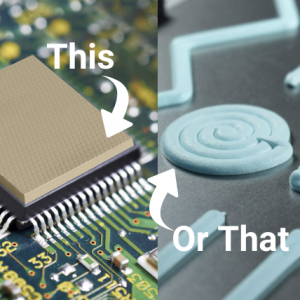Selecting a Thermal Gel or Thermal Gap Pad – Your Questions Answered (Part I)
This is the first part in a two-part blog post series answering the questions you asked during the webinar Selecting a Thermal Gel or Thermal Gap Pad now, available on-demand.
The objective of thermal management programs in electronics packaging is the efficient removal of heat from the semiconductor junction to the ambient environment. While selecting a material for your application can be daunting, two of the most popular thermal interface materials you should consider are thermal gap filler pads and dispensed thermal gels.
In our recent webinar Selecting a Thermal Gel or Thermal Gap Pad, available on-demand,we answered your most interesting and thought-provoking questions.
What is the difference between thermal resistance and thermal impedance?
Thermal resistance is a measure of how a material of a specific thickness resists the flow of heat. Thermal impedance is a more comprehensive value as it is the sum of the material thermal resistance as well as the contact resistance.
Because real surfaces are never truly flat or smooth, the contact plane between a surface and a material can also produce a resistance to the flow of heat. Surface irregularities on a micro-scale and surface warp on a macro scale create contact points and microscopic air-filled voids. Air voids resist the flow of heat and force more of the heat to flow through the contact points.
This constriction resistance is referred to as surface contact resistance and can be a factor at all contacting surfaces.
What does PEN stand for when referring to your PEN film carriers for thermal gap pads?
PEN stands for polyethylenenaphthalate and is a common carrier used to improve the durability of thermal gap pads. This carrier permits the gap pad to see a shearing motion and offers a clear, cost-effective dielectric film with fair thermal performance.
Do THERM-A-GAP GELs cure?
One of the most important properties of thermal dispensable GELs is that there is no cure required, as they are supplied in a fully cured state from Parker Chomerics. THERM-A-GAP GEL materials do not change properties once dispensed and do not require any processing after being dispensed.
Used within the limits of recommended operating conditions, GELs will not be become brittle, will not harden, will not flow, and will not soften over time.
What are the re-workability requirements for thermal GELs and gap pads?
THERM-A-GAP gap filler pads have a very easy work process. They can be easily peeled off and replaced with identical gap pads. Using a clean cloth with a solvent such as an isopropyl alcohol (IPA) will clean the surface and help reduce contact resistance as well as adhesion of the pads. The rework process for thermal GELs is similar.
Using a rag with a bit of IPA or similar solvent, simply wipe the previous gel away. Re-dispense the necessary amount of gel back onto the board or component and the process is complete. GELs should be re-dispensed every time the enclosure is opened.
Gap filler pads are more durable but should be replaced if the enclosure is opened after being in a compressed state for an extended period.
Do THERM-A-GAP GELs or gap filler pads experience long term creep?
THERM-A-GAP GELs and thermal gap filler pads go through extensive reliability testing (based on automotive standards) to ensure long term product survivability. GELs are formulated to resist sagging or flowing out of applications, especially in properly compressed situations.
THERM-A-GAP thermal gap filler pads, even in vertical applications, should not move out of applications if proper compression is maintained. Gap pads will experience a compression set and should be replaced after extended periods of time in a compressed state.
What are some current standards or specifications for THERM-A-GAP GELs and putties?
We meet ROHS standards with all our thermal materials and meet ASTM standards with regards to the thermal and electrical properties. Reliability testing is conducted on our GELs and putties with tests based on automotive standards such as GMW 3172.
Does E.S. Electronic Service GmbH have internal manufacturing capabilities for cutting gap pads?
We can cut thermal gap filler pads to nearly any shape or size. We have a variety of cutting techniques that can be used for complex geometries and higher volume repeatability. Select your material we’ll get started on your quote right away.
Stay tuned for part II as we dive into more of your questions.





